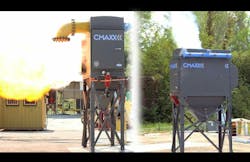Enhancing industrial safety with inline deflagration arresters
Key takeaways:
- IDA systems provide flame suppression directly through the primary filter.
- IDA systems are particularly beneficial for facilities that return filtered air back into the building to conserve energy.
- IDA systems require particulate monitors downstream of the filters to continuously check for dust bypassing the filters, which could indicate filter wear or damage.
- Existing dust collection systems can be retrofitted by upgrading the filters to IDA-certified versions and installing a particulate monitor for continuous monitoring.
In industries that deal with combustible dust, ensuring the safety of personnel and facilities is a top priority. While dust collection systems are essential for maintaining clean and safe work environments, they can also pose significant explosion hazards. One solution that has gained traction for mitigating these risks is the inline deflagration arrester (IDA). Developed through rigorous testing, IDA systems are designed to prevent flame fronts from propagating back into buildings, providing an added layer of protection for industrial operations.
IDA system operation and development
An IDA is a specialized safety device installed within an industrial dust collection system that acts as a flame arrester, preventing explosions from traveling back through the system’s clean-air return line and into the facility. Unlike traditional methods that may require secondary filtration systems, an IDA system provides flame suppression directly through the primary filter, simplifying the overall safety approach.
The IDA system was developed following extensive real-world testing of dust collection systems. At Imperial Systems, the CMAXX dust collector served as the foundation for these tests. Utilizing KST 185 test dust, engineers conducted a series of controlled explosions to evaluate the system's ability to stop flame propagation.
To simulate worst-case scenarios, the testing involved sealing both the explosion vent and the upstream air intake, forcing the explosion entirely through the filters. For certification, the system needed to withstand three consecutive explosion tests without any flame transmission. The DeltaMAXX filters used in the IDA system were reinforced for durability, successfully containing the explosions and preventing downstream flame travel.
Ideal applications for IDA systems
IDA systems are particularly beneficial for facilities that choose to return filtered air back into the building. This is often done to conserve energy, especially in colder climates where heated air would otherwise be lost. Similarly, companies in warmer regions with air-conditioned facilities can reduce cooling costs by recirculating air.
However, not all applications are ideal for IDA systems. Materials with KST values above 185 or highly hazardous dusts may necessitate additional protective measures, such as secondary HEPA filters or active explosion suppression systems. In these scenarios, a tailored safety strategy is essential.
Advantages over traditional explosion protection methods
Compared to traditional explosion protection methods, IDA systems offer several advantages:
Cost savings: IDA systems eliminate the need for secondary filtration units, reducing initial installation and ongoing maintenance costs.
Efficient maintenance: With only one set of filters to manage, companies experience simplified maintenance and reduced downtime.
Energy conservation: Recirculating air using IDA-certified filters allows companies to maintain indoor temperature control more effectively.
Ensuring long-term safety
A key feature of the IDA system is the integration of a particulate monitor downstream of the filters. This device continuously checks for any dust bypassing the filters, which could indicate filter wear or damage. If particulate levels exceed a predetermined threshold, the monitor triggers an alert, allowing operators to take immediate corrective action. This proactive approach enhances the long-term safety and reliability of the dust collection system.
Retrofitting existing dust collection systems
For companies with existing CMAXX dust collection systems, retrofitting to include IDA certification is a practical option. This involves upgrading filters to the robust DeltaMAXX IDA-certified versions and installing a particulate monitor for continuous monitoring. Certified technicians can assess the system and ensure that it meets the necessary safety standards.
Real-world applications
Numerous facilities across industries have successfully integrated IDA systems into their operations. In one case, a northern manufacturing plant faced challenges with energy costs during winter. By installing an IDA system, they were able to safely return warm, filtered air to the facility, significantly reducing heating expenses.
In another scenario, a company with a legacy dust collection system opted to retrofit their system for IDA certification. The streamlined upgrade provided them with enhanced explosion protection and improved compliance with safety regulations.
A reliable, cost-effective solution
IDA systems offer a reliable, cost-effective solution for preventing flame propagation in industrial dust collection systems. With rigorous testing, simplified maintenance, and energy-saving benefits, IDA systems are an ideal choice for companies looking to enhance their safety protocols.
By understanding the specific needs of the facility, evaluating dust explosion risks, and considering factors such as air return preferences and material characteristics, companies can determine if an IDA system is the right fit. For companies seeking to strengthen their explosion protection strategy, consulting with an experienced provider can ensure optimal safety and compliance.
About the Author

Justin Badger
Justin Badger is the national sales & marketing manager at Imperial Systems. With over a decade of experience in the dust collection and industrial safety industry, Badger specializes in helping companies navigate combustible dust hazards and implement effective safety solutions. His passion for advancing safety through rigorous testing and innovative technology has made him a leader in the field.


